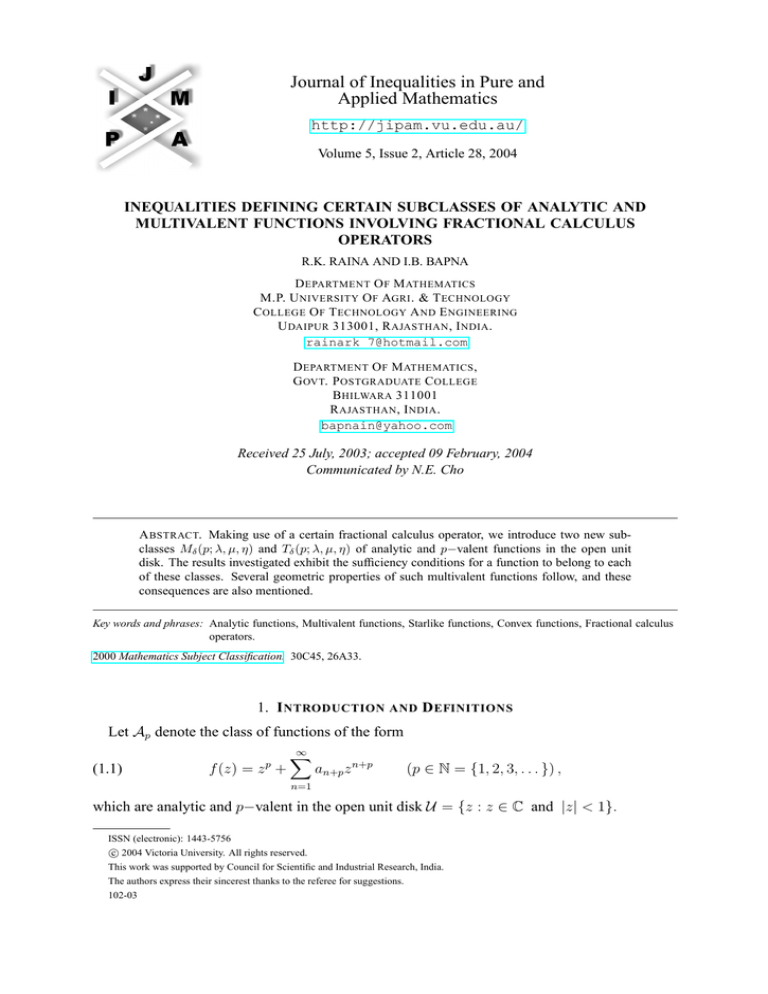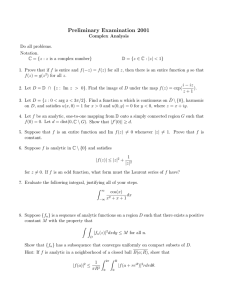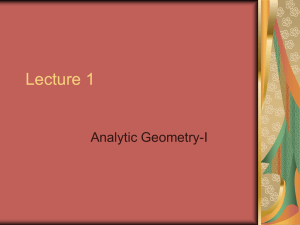
Journal of Inequalities in Pure and
Applied Mathematics
http://jipam.vu.edu.au/
Volume 5, Issue 2, Article 28, 2004
INEQUALITIES DEFINING CERTAIN SUBCLASSES OF ANALYTIC AND
MULTIVALENT FUNCTIONS INVOLVING FRACTIONAL CALCULUS
OPERATORS
R.K. RAINA AND I.B. BAPNA
D EPARTMENT O F M ATHEMATICS
M.P. U NIVERSITY O F AGRI . & T ECHNOLOGY
C OLLEGE O F T ECHNOLOGY A ND E NGINEERING
U DAIPUR 313001, R AJASTHAN , I NDIA .
rainark_7@hotmail.com
D EPARTMENT O F M ATHEMATICS ,
G OVT. P OSTGRADUATE C OLLEGE
B HILWARA 311001
R AJASTHAN , I NDIA .
bapnain@yahoo.com
Received 25 July, 2003; accepted 09 February, 2004
Communicated by N.E. Cho
A BSTRACT. Making use of a certain fractional calculus operator, we introduce two new subclasses Mδ (p; λ, µ, η) and Tδ (p; λ, µ, η) of analytic and p−valent functions in the open unit
disk. The results investigated exhibit the sufficiency conditions for a function to belong to each
of these classes. Several geometric properties of such multivalent functions follow, and these
consequences are also mentioned.
Key words and phrases: Analytic functions, Multivalent functions, Starlike functions, Convex functions, Fractional calculus
operators.
2000 Mathematics Subject Classification. 30C45, 26A33.
1. I NTRODUCTION AND D EFINITIONS
Let Ap denote the class of functions of the form
(1.1)
f (z) = z p +
∞
X
an+p z n+p
(p ∈ N = {1, 2, 3, . . . }) ,
n=1
which are analytic and p−valent in the open unit disk U = {z : z ∈ C and |z| < 1}.
ISSN (electronic): 1443-5756
c 2004 Victoria University. All rights reserved.
This work was supported by Council for Scientific and Industrial Research, India.
The authors express their sincerest thanks to the referee for suggestions.
102-03
2
R.K. R AINA AND I.B. BAPNA
A function f (z) ∈ Ap is said to be p−valently starlike in U, if
0 zf (z)
(1.2)
<
>0
(z ∈ U),
f (z)
and the function f (z) ∈ Ap is said to be p−valently convex in U, if
zf 00 (z)
(1.3)
< 1+ 0
>0
(z ∈ U).
f (z)
Further, a function f (z) ∈ Ap is said to be p−valently close-to-convex in U, if
0 f (z)
(1.4)
<
>0
(z ∈ U).
z p−1
One may refer to [1], [2] and [9] for above definitions and other related details.
λ,µ,η
The operator J0,z
occurring in this paper is the Saigo type fractional calculus operator
defined as follows ([8]):
Definition 1.1. Let 0 ≤ λ < 1 and µ,η ∈ R, then
λ−µ Z z
z
t
d
λ,µ,η
−λ
(1.5) J0,z f (z) =
(z − t) F1 µ − λ, 1 − η; 1 − λ; 1 −
f (t)dt ,
dz Γ(1 − λ) 0
z
where the function f (z) is analytic in a simply-connected region of the z-plane containing the
origin, with the order
f (z) = O (|z|ε ) (z → 0), where ε > max{0, µ − η} − 1.
It being understood that (z − t)−λ denotes the principal value for 0 ≤ arg(z − t) < 2π.
The 2 F1 function occurring in the right-hand side of (1.5) is the familiar Gaussian hypergeometric function (see [9] for its definition).
Definition 1.2. Under the hypotheses of Definition 1.1, a fractional calculus operator
λ+m,µ+m,η+m
J0,z
is defined by ([7])
(1.6)
λ+m,µ+m,η+m
J0,z
f (z) =
dm λ,µ,η
J
f (z) (z ∈ U; m ∈ N0 = {0} ∪ N) .
dz m 0,z
We observe that
(1.7)
λ,λ,η
Dzλ f (z) = J0,z
f (z)
(0 ≤ λ < 1),
and
(1.8)
λ+m,λ+m,η+m
Dzλ+m f (z) = J0,z
f (z)
(0 ≤ λ < 1; m ∈ N0 ),
where Dzλ+m is the well known fractional derivative operator ([6], [9]).
We introduce here two subclasses of functions Mδ (p; λ, µ, η) and Tδ (p; λ, µ, η) which are
defined as follows.
Definition 1.3. Let δ ∈ R \ {0}, p ∈ N, 0 ≤ λ < 1, µ < 1, and η > max(λ, µ) − p − 1. Then
the function f (z) ∈ Ap is said to belong to Mδ (p; λ, µ, η) if it satisfies the inequality
!δ
λ+1,µ+1,η+1
zJ0,z
f (z)
δ
− (p − µ) < (p − µ)δ
(1.9)
(z ∈ U),
λ,µ,η
J0,z f (z)
δ
λ+1,µ+1,η+1
λ,µ,η
f (z)/J0,z f (z) is taken as its principal value.
where the value of z J0,z
J. Inequal. Pure and Appl. Math., 5(2) Art. 28, 2004
http://jipam.vu.edu.au/
I NEQUALITIES D EFINING S UBCLASSES OF A NALYTIC AND M ULTIVALENT F UNCTIONS
3
Definition 1.4. Under the hypotheses of Definition 1.3, the function f (z) ∈ Ap is said to belong
to Tδ (p; λ, µ, η) if it satisfies the inequality
δ Γ(p + 1)Γ(p + η − µ + 1) δ µ−p λ,µ,η
(1.10) z J0,z f (z) −
Γ(p − µ + 1)Γ(p + η − λ + 1) δ
Γ(p + 1)Γ(p + η − µ + 1)
<
(z ∈ U),
Γ(p − µ + 1)Γ(p + η − λ + 1)
δ
λ,µ,η
where the value of z µ−p J0,z
f (z) is considered to be its principal value. For λ = µ, we
have
(1.11)
Mδ (p; µ, µ, η) = Mδ (p; µ),
and
(1.12)
Tδ (p; µ, µ, η) = Tδ (p; µ).
The classes Mδ (p; µ)and Tδ (p; µ) were studied recently in [4]. In view of the operational
relation (1.8), it may be noted that the functions in M1 (p; 0) are p−valently starlike in U,
whereas, the functions inT1 (p; 1) are p−valently close-to-convex in U.
In this paper we investigate characterization properties giving sufficiency conditions for functions of the form (1.1) to belong to the classes Mδ (p; λ, µ, η) and Tδ (p; λ, µ, η) involving the
fractional calculus operator (1.6). Several consequences of the main results and their relevance
to known results are also pointed out.
2. R ESULTS R EQUIRED
We mention the following results which are used in the sequel:
Lemma 2.1. ([8]). If 0 ≤ λ < 1; µ,η ∈ R and k > max{0, µ − η} − 1, then
Γ(1 + k)Γ(1 − µ + η + k) k−µ
λ,µ,η k
z .
(2.1)
J0,z
z =
Γ(1 − µ + k)Γ(1 − λ + η + k)
Lemma 2.2. ([5]). Let w(z) be an analytic function in the unit disk U with w(0) = 0, and let
0 < r < 1. If |w(z)| attains at z0 its maximum value on the circle |z| = r, then
(2.2)
z0 w0 (z0 ) = kw(z0 )
(k ≥ 1).
3. M AIN R ESULTS
We begin by proving
Theorem 3.1. Let δ ∈ R \ {0}, p ∈ N, 0 ≤ λ < 1, µ < 1, η > max(λ, µ) − p − 1, and
a > 0, b ≥ 0, such that a + 2b ≤ 1. If a function f (z) ∈ Ap satisfies the inequality
!#
"
λ+1,µ+1,η+1
λ+2,µ+2,η+2
J0,z
f (z) J0,z
f (z)
−
(3.1) < 1 + z
λ+1,µ+1,η+1
λ,µ,η
J0,z
f (z)
J0,z
f (z)
a+b
<
(δ > 0)
δ(1 + a)(1 − b)
(z ∈ U),
a
+
b
>
(δ < 0)
δ(1 + a)(1 − b)
then f (z) ∈ Mδ (p; λ, µ, η).
J. Inequal. Pure and Appl. Math., 5(2) Art. 28, 2004
http://jipam.vu.edu.au/
4
R.K. R AINA AND I.B. BAPNA
Proof. Let f (z) ∈ Ap , and define a function w(z) by
!δ
λ+1,µ+1,η+1
zJ0,z
f (z)
1 + aw(z)
δ
(3.2)
= (p − µ)
λ,µ,η
1 − bw(z)
J0,z
f (z)
(z ∈ U).
Then it follows from (2.1) that w(z) is analytic function in U, and w(0) = 0. Differentiation of
(3.2) gives
(
!)
λ+2,µ+2,η+2
λ+1,µ+1,η+1
J0,z
f (z) J0,z
f (z)
(a + b)zw0 (z)
1
(3.3) 1 + z
−
=
λ+1,µ+1,η+1
λ,µ,η
δ (1 + aw(z)) (1 − bw(z))
J0,z
f (z)
J0,z
f (z)
= φ(z) (say).
Assume that there exists a point z0 ∈ U such that
max |w(z)| = |w(z0 )| = 1.
|z|≤|z0 |
Then, applying Lemma 2.2, we can write
z0 w0 (z0 ) = kw(z0 )
(k ≥ 1),
and w(z0 ) = eiθ (θ ∈ [0, 2π)), so that from (3.3) we have
w(z0 )
k(a + b)
<{φ(z0 )} =
<
δ
(1 + aw(z0 )) (1 − bw(z0 ))
k
1
1
= <
−
δ
1 − bw(z0 ) 1 + aw(z0 )
k
1 − be−iθ
1 + ae−iθ
−
= <
δ
1 + b2 − 2b cos θ 1 + a2 + 2a cos θ
)
(
k∆
k
1
1
=
,
−
=
2 −1
2 −1
a
b
δ
δ 2 + 1−b cos θ
2 + 1+a cos θ
where θ 6= cos−1 (−1/a) and θ 6= cos−1 (−1/b).
Simple calculations (under the constraints mentioned with the hypotheses for the parameters
(a+b)
, and since k ≥ 1, it follows that
a and b) yield that ∆ ≥ (1+a)(1−b)
(a+b)
> δ(1+a)(1−b)
(δ > 0),
k∆
(3.4)
<{φ(z0 )} =
δ
< (a+b)
(δ < 0).
δ(1+a)(1−b)
This contradicts our condition (3.1), and we conclude from (3.2) that
!δ
λ+1,µ+1,η+1
(a + b)w(z) zJ0,z
f (z)
δ
δ
− (p − µ) = (p − µ) λ,µ,η
1 − bw(z) J0,z
a+b
δ
< (p − µ)
≤ (p − µ)δ .
1−b
This completes the proof of Theorem 3.1.
Next we prove
J. Inequal. Pure and Appl. Math., 5(2) Art. 28, 2004
http://jipam.vu.edu.au/
I NEQUALITIES D EFINING S UBCLASSES OF A NALYTIC AND M ULTIVALENT F UNCTIONS
5
Theorem 3.2. Let δ ∈ R \ {0}, p ∈ N, 0 ≤ λ < 1, µ < 1, η > max(λ, µ) − p − 1, and a > 0,
b ≥ 0 such that a + 2b ≤ 1. If a function f (z) ∈ Ap satisfies the inequality
a+b
! < p − µ +
(δ > 0)
λ+1,µ+1,η+1
δ(1+a)(1−b)
zJ0,z
f (z)
(3.5)
<
(z ∈ U),
λ,µ,η
a+b
J0,z
> p − µ + δ(1+a)(1−b)
(δ > 0)
then f (z) ∈ Tδ (p; λ, µ, η).
Proof. Consider
δ Γ(1 + p)Γ(1 + p + η − µ) δ 1 + aw(z) µ−p λ,µ,η
(3.6)
z J0,z f (z) =
(z ∈ U).
Γ(1 + p − µ)Γ(1 + p + η − λ)
1 − bw(z)
Using the same method as elucidated in the proof of Theorem 3.1, we arrive at the desired
result.
Remark 3.3. If we set λ = µ, a = 1, b = 0, then Theorems 3.1 and 3.2 by appealing to the
operational relation (1.8) correspond to the recently established results due to Irmak et al. [4,
pp. 271–272].
Theorems 3.1 and 3.2 would also yield various results involving analytic and multivalent
functions by suitably choosing the values of a, b, δ, µ and p. Setting δ = 1 in Theorems 3.1 and
3.2, we have
Corollary 3.4. Let p ∈ N, 0 ≤ λ < 1, µ < 1, η > max(λ, µ) − p − 1, and a > 0, b ≥ 0 such
that a + 2b ≤ 1. If a function f (z) ∈ Ap satisfies the inequality
!)
(
λ+1,µ+1,η+1
λ+2,µ+2,η+2
f (z)
J0,z
f (z) J0,z
a+b
(3.7) < 1 + z
−
<
(z ∈ U),
λ+1,µ+1,η+1
λ,µ,η
(1 + a)(1 − b)
J0,z
f (z)
J0,z f (z)
then f (z) ∈ M1 (p; λ, µ, η).
Corollary 3.5. Let p ∈ N, 0 ≤ λ < 1, µ < 1, η > max(λ, µ) − p − 1, and a > 0, b ≥ 0 such
that a + 2b ≤ 1. If a function f (z) ∈ Ap satisfies the inequality
!
λ+1,µ+1,η+1
zJ0,z
f (z)
a+b
<p−µ+
(3.8)
<
(z ∈ U),
λ,µ,η
(1 + a)(1 − b)
J0,z f (z)
then f (z) ∈ T1 (p; λ, µ, η).
Corollaries 3.4 and 3.5 on putting λ = µ = 0, and using (1.8) give the following results:
Corollary 3.6. Let p ∈ N, a > 0, b ≥ 0 such that a + 2b ≤ 1. If a function f (z) ∈ Ap satisfies
the inequality
zf 00 (z) zf 0 (z)
a+b
(3.9)
< 1+ 0
−
<
(z ∈ U),
f (z)
f (z)
(1 + a)(1 − b)
then f (z) is p-valently starlike in U.
Corollary 3.7. Let p ∈ N, a > 0, b ≥ 0 such that a + 2b ≤ 1. If a function f (z) ∈ Ap satisfies
the inequality
zf 0(z)
a+b
(3.10)
<
<p+
(z ∈ U),
f (z)
(1 + a)(1 − b)
n
o
f (z)
then < zp > 0, (z ∈ U).
J. Inequal. Pure and Appl. Math., 5(2) Art. 28, 2004
http://jipam.vu.edu.au/
6
R.K. R AINA AND I.B. BAPNA
Lastly, Corollaries 3.4 and 3.5 on putting λ = µ = 1, and using (1.8) give
Corollary 3.8. Let p ∈ N, a > 0, b ≥ 0 such that a + 2b ≤ 1. If a function f (z) ∈ Ap satisfies
the inequality
zf 000 (z) zf 00 (z)
a+b
(3.11)
< 1 + 00
− 0
<
(z ∈ U),
f (z)
f (z)
(1 + a)(1 − b)
then f (z) is p−valently convex in U.
Corollary 3.9. Let p ∈ N, a > 0, b ≥ 0 such that a + 2b ≤ 1. If a function f (z) ∈ Ap satisfies
the inequality
00 zf (z)
a+b
(3.12)
<
<p−1+
(z ∈ U),
0
f (z)
(1 + a)(1 − b)
then f (z) is p−valently close-to -convex in U.
Remark 3.10. When a = 1, b = 0, then the Corollaries 3.6 – 3.9 correspond to the known
results [3, pp. 457–458] involving inequalities on p−valent functions.
R EFERENCES
[1] P.L. DUREN, Univalent Functions, Grundlehren der Mathematischen Wissenschaffen 259,
Springer-Verlag, NewYork, Berlin, Heidelberg and Tokyo (1983).
[2] A.W. GOODMAN, Univalent Functions, Vols. I and II, Polygonal Publishing House, Washington,
New Jersy, 1983.
[3] H. IRMAK AND O.F. CETIN, Some theorems involving inequalities on p−valent functions, Turkish
J. Math., 23 (1999), 453–459.
[4] H. IRMAK, G. TINAZTEPE, Y.C. KIM AND J.H. CHOI, Certain classes and inequalities involving
fractional calculus and multivalent functions, Fracl.Cal. Appl. Anal., 3 (2002), 267–274.
[5] I.S. JACK, Functions starlike and convex of order α, J. London Math. Soc., 3 (1971), 469–474.
[6] S. OWA, On the distortion theorems. I, Kyungpook Math. J., 18 (1978), 53–59
[7] R.K. RAINA AND JAE HO CHOI, Some results connected with a subclass of analytic functions
involving certain fractional calculus operators, J. Fracl. Cal., 23 (2003), 19–25.
[8] R.K. RAINA AND H.M. SRIVASTAVA, A certain subclass of analytic functions associated with
operators of fractional calculus, Comput. Math. Appl., 32 (1996), 13–19.
[9] H.M. SRIVASTAVA AND S. OWA (Eds.), Current Topics in Analytic Function Theory, World Scientific Publishing Company, Singapore, New Jersey, London, and Hong Kong, 1992.
J. Inequal. Pure and Appl. Math., 5(2) Art. 28, 2004
http://jipam.vu.edu.au/









